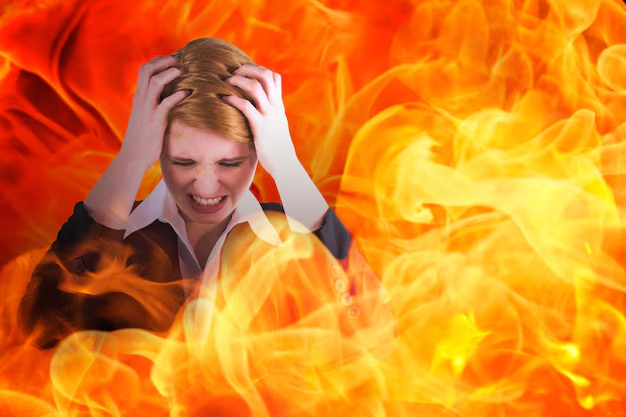Understanding the Sensation of Rosacea: Does It Really Burn?
Imagine a cool breeze on a hot summer's day. It's refreshing and soothing. Now imagine that breeze is instead mixed with the sensation of heat and discomfort across your face. This is how many people describe living with rosacea—a condition that prompts questions like: "Does rosacea burn?" Let's explore this question in depth and unravel the complexities of this common skin condition.
What is Rosacea?
Rosacea is a chronic skin condition commonly affecting the face, characterized by redness, visible blood vessels, and sometimes acne-like bumps. It often begins with a tendency to blush or flush more easily than other people. Over time, this redness can become more persistent and noticeable.
Key characteristics of rosacea include:
- Persistent redness (especially across the cheeks, nose, chin, or forehead)
- Swelling and a burning sensation
- Visible blood vessels
- Rough or swollen skin
The Burning Sensation: Real or Imagined?
The Physical Sensation of Burning
Many individuals living with rosacea report experiencing a burning or stinging sensation on their skin. This is not just an imagined feeling but can be attributed to the underlying mechanisms of the condition. The skin becomes hypersensitive due to increased blood flow to the surface and inflammation.
Why Does Rosacea Cause Burning?
Several factors contribute to this sensation:
- Inflammation: Rosacea leads to inflammation of the blood vessels and skin tissues, which can result in a burning feeling.
- Hypersensitivity: The condition may make the skin more sensitive to stimuli such as heat, sunlight, and certain skin products.
- Nerve Reactions: Rosacea can affect how the nerves in the skin respond, leading to sensations such as burning or stinging.
Is Burning a Consistent Symptom?
Not everyone with rosacea experiences burning. The condition can present itself in different forms, and the intensity can vary. While some may feel constant discomfort, others might experience it only during flare-ups triggered by certain factors.
Understanding Triggers
Common Rosacea Triggers
Identifying and avoiding triggers is crucial to managing rosacea. Some common triggers include:
- Sun exposure: UV light can exacerbate symptoms.
- Hot or spicy foods: May provoke flushing and discomfort.
- Alcohol: Especially red wine, can trigger a flare-up.
- Extreme temperatures: Both hot and cold weather can contribute.
- Stress and emotional factors: Often linked to exacerbations.
Tailoring Lifestyle Choices
Making informed lifestyle changes can be beneficial. Here are some tips:
- Use sunscreen daily to protect against harmful UV rays.
- Keep a diary to track triggers and identify patterns.
- Opt for gentle skincare products to reduce irritation.
Types of Rosacea
Four Main Types
Understanding which type of rosacea you have can guide you in managing symptoms:
- Erythematotelangiectatic Rosacea: Characterized by redness and visible blood vessels.
- Papulopustular Rosacea: Often mistaken for acne; includes redness with swelling and breakouts.
- Phymatous Rosacea: Skin thickening and enlargement; often affects the nose.
- Ocular Rosacea: Affects the eyes, causing redness, irritation, and a burning sensation around the eyes.
Does the Type Affect the Sensation of Burning?
Yes, the type of rosacea can influence symptoms. For example, ocular rosacea is more likely to cause burning, particularly around the eyes, compared to other types.
Managing Rosacea: Practical Tips
Skin Care Routine
- Cleanse with care: Use mild, fragrance-free cleansers.
- Hydrate the skin: Moisturizing reduces irritation and strengthens the skin barrier.
- Avoid harsh exfoliants: These can worsen symptoms.
Lifestyle Adjustments
- Manage stress through meditation or yoga.
- Stay hydrated by drinking plenty of water.
- Limit alcohol and spicy foods to reduce flushing.
When to Seek Help
While lifestyle changes and over-the-counter solutions can help, some cases may need professional attention. Consider consulting a dermatologist if:
- Symptoms worsen or do not improve with at-home care.
- New symptoms develop that cause concern.
- You notice impacts on your quality of life.
Myths and Misconceptions
Misunderstanding Rosacea
Despite its prevalence, rosacea is often misunderstood. Some common myths include:
- Rosacea is just acne: While it may look similar, it is distinct and usually involves underlying inflammation and vascular issues.
- Only fair-skinned people get rosacea: It can affect individuals of all skin tones, though it may present differently.
- Rosacea is due to poor hygiene: This is false; it's a medical condition linked to genetic and environmental factors.
Separating Fact from Fiction
Clarifying these misconceptions helps in understanding the condition and reducing stigma, encouraging more people to seek appropriate management options.
Living with Rosacea
Emotional Impact
The visible nature of rosacea often leads to emotional and psychological effects, impacting confidence and social interactions. Support from family, friends, and support groups can provide comfort and understanding.
Building Resilience
- Educate yourself: Understanding your condition can empower you.
- Connect with others: Sharing experiences can provide emotional support.
- Focus on self-care: Prioritizing your well-being can improve your outlook.
In conclusion, rosacea can indeed cause a burning sensation, which is a common symptom experienced by many. Understanding the nuances of this condition—its triggers, types, and management strategies—can help individuals navigate daily life more comfortably. Prioritizing skin care, identifying and managing personal triggers, and seeking guidance when necessary are critical steps towards living well with rosacea.
Quick Summary for Rosacea Management 🌟
- Understand triggers: Sun, spicy foods, stress.
- Use gentle skin products: Avoid irritants.
- Stay hydrated: 🍶 Drink plenty of water.
- Manage stress: 🧘♀️ Practice relaxation techniques.
- Consult a dermatologist: If symptoms persist.
- Seek support: Connect with support groups. ❤️
Knowledge and proactive management are your best tools in addressing the burning sensation and other symptoms of rosacea. Embrace these strategies for a more comfortable journey with your skin.
